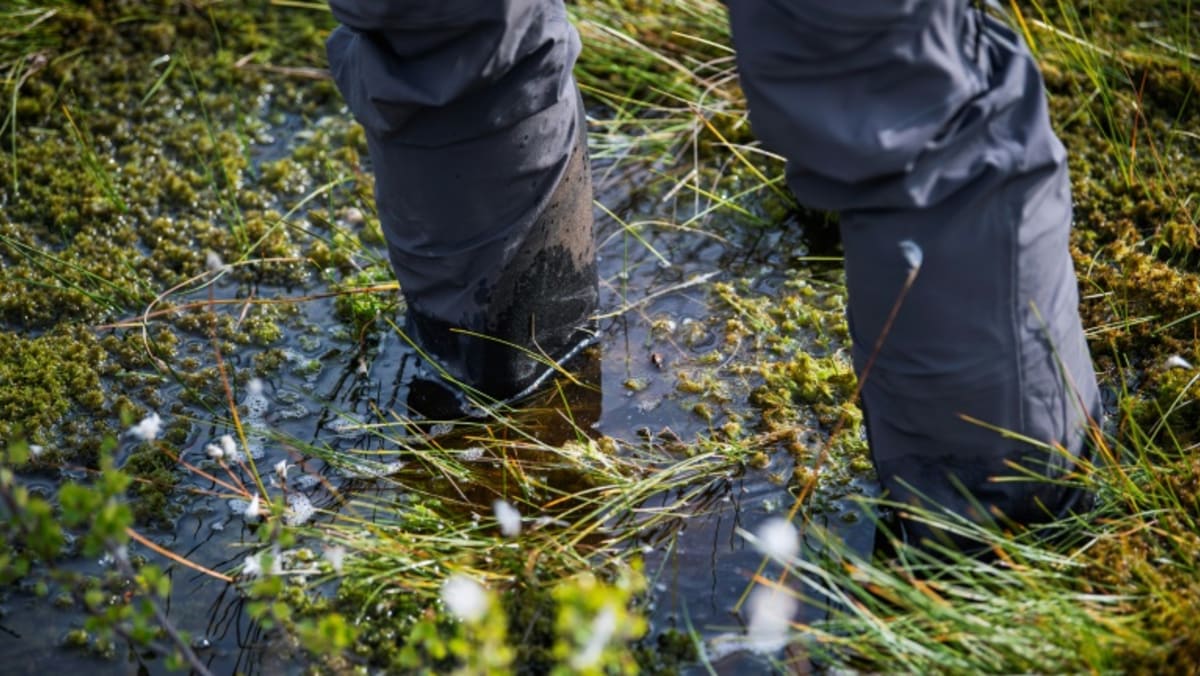Permafrost: A ticking carbon time bomb
CRACKS IN THE GROUND
In Abisko, a small lakeside town with traditional red brick and wooden buildings known as a popular spot for viewing the northern lights, telltale signs of thawing permafrost are there if you know where to look.
Tears in the ground have opened up and slumping soil is visible around the picturesque town. Rows of telephone poles are tilting because the ground has started to shift.
In Alaska, where permafrost is found beneath nearly 85 per cent of the land, thawing permafrost is causing roads to warp.
Cities in Siberia have seen buildings start to crack as the ground shifts. In Yakutsk, the world’s largest city built on permafrost, some buildings have already had to be demolished.
The deterioration of permafrost affects water, sewage and oil pipes as well as buried chemical, biological and radioactive substances, Russia’s environment ministry said in a report in 2019.
Last year, a fuel tank ruptured after its supports suddenly sank into the ground near the Siberian city of Norilsk, spilling 21,000 tonnes of diesel into nearby rivers.
Norilsk Nickel blamed thawing permafrost that had weakened the plant’s foundation.
Across the Arctic, permafrost thaw could affect up to around two thirds of infrastructure by mid-century, according to a draft IPCC report, seen by AFP in June ahead of its scheduled release by the UN in February.
More than 1,200 settlements, 36,000 buildings and four million people would be affected, it said.
It can lead to other dramatic changes in the landscape too, such as trapping water to form new ponds or lakes, or opening up a new path for water drainage, leaving the area completely dry.
THREATENING PARIS GOALS
The planet-warming gases escaping from permafrost threaten the hard-won Paris climate goals, scientists have warned.
Countries that signed the 2015 treaty vowed to cap the rise in global temperatures at well below 2 degrees Celsius – 1.5 degrees Celsius if possible – compared to preindustrial levels.
To have a two-thirds chance of staying under the 1.5 degrees Celsius cap, humanity cannot emit more than 400 billion tonnes of CO2, the IPCC recently concluded.
At current rates of emissions, our “carbon budget” would be exhausted within a decade.
But carbon budgets do “not fully account for” the wild card of a rapid discharge in greenhouse gases from natural sources in the Arctic, warned a study this year, published in the Proceedings of the National Academy of Sciences of the United States of America.
Many climate models currently do not take permafrost into account because it is difficult to project the net effects of the permafrost thawing, Hugelius says.
Emissions in some areas are offset by the “greening of the Arctic” as certain plants thrive in the warmer temperatures, he adds.
However, the latest IPCC report from August did raise the issue of melting permafrost and stated that “further warming will amplify permafrost thawing”, he says.
Action taken now can still have a strong effect on the speed of the thaw, Larson stresses.
Even if “we actually don’t have control over the rate of thaw of the permafrost soils” that does not mean “we shouldn’t turn off the fossil fuels and change how we live on this planet”, he says.
Some changes driven by warming temperatures in the Arctic are already irreversible, he adds sadly.
TRADITION SLIPPING AWAY
“Around here we’ve been reindeer herding for at least 1,000 years,” says Tomas Kuhmunen, a member of the indigenous Sami community.
Wearing a peaked bobble hat in traditional blue, red and yellow, he is standing on top of Luossavaara mountain overlooking Kiruna, Sweden’s northernmost town that has grown up around an iron mine.
Kuhmunen, 34, works with the Sami Parliament but is also a reindeer herder, a practice passed down the generations for as far back as he can trace his family records, which is until the 1600s.
Unlike in his ancestors’ days, modern times have forced the grazing reindeer to negotiate roads, rail tracks, wind power plants and mines.
Today, they must also adapt to the warming climate.
For all the latest world News Click Here

